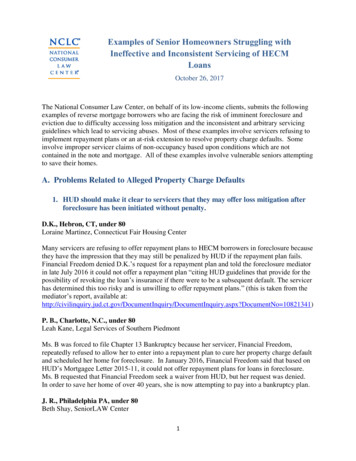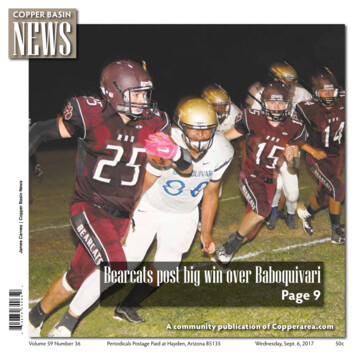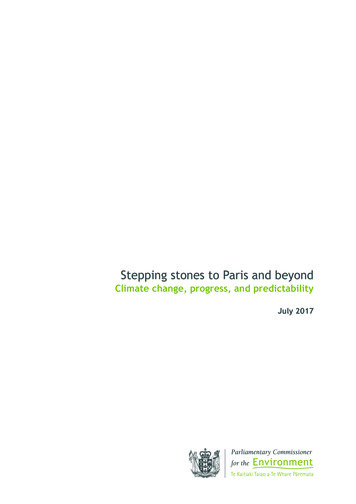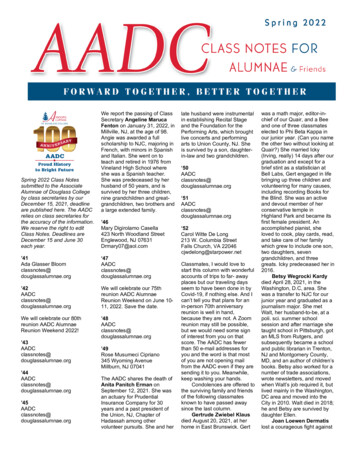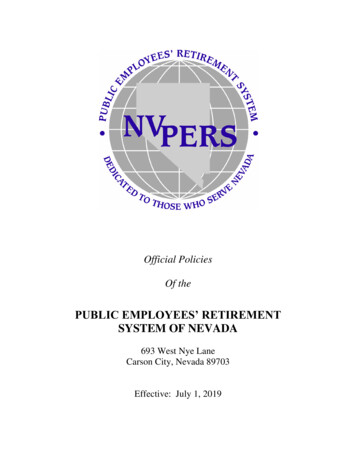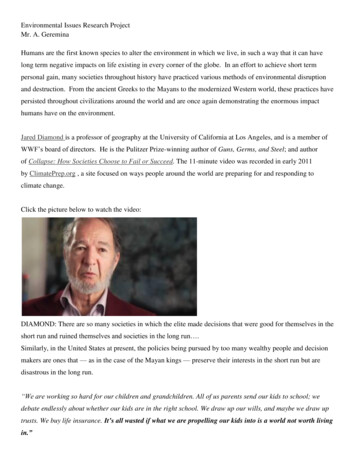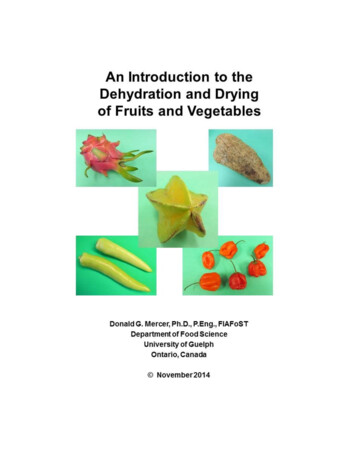
Transcription
The material presented here has been copyrighted as ameans of protecting this body of work. It is not my intentionto impose any restrictions on the printing, copying, ordistribution of this information. If you find any of the chaptersuseful for your drying activities, or if you would like to useanything for instructional purposes, please feel free to do so.A reference citing the source of any material which isreproduced would be greatly appreciated, whenever it isused.As author, I assume no responsibility, nor liability, for anyproblems of any nature or manner which may beencountered through the application of the principlesdiscussed here. Your drying equipment, starting materials,and individual applications will almost certainly imposeconditions that will create unique situations. These cannotbe anticipated in a general context such as that presentedhere. Donald G. MercerNovember 2014ISBN 978-0-88955-621-8
To Our GrandchildrenEthan, Mataya, and Keeleigh
An Introduction to the Dehydration and Dryingof Fruits and VegetablesContentsChapterPart 1: Food Drying Basics1.Introduction1.1 Introduction1.2 Objectives2.Reasons for Drying Fruits and Vegetables2.1 Introduction2.2 Defining the Terms “Dehydration and Drying”2.3 Prolonged Storage Life2.4 Weight Reduction2.5 Volume Reduction2.6 Taste and Texture2.7 Form Changes2.8 Convenience and Variety3.Factors Influencing Food Quality3.1 Introduction3.2 Overall Appearance3.3 Feel3.4 Aroma3.5 Source3.6 Taste3.7 Variety3.8 Other Aspects4.Initial Preparation Steps4.1 Introduction4.2 Inspection4.3 Washing4.4 Separation of Process Streams4.5 Worker Sanitation PracticesContents:Page 1
5.An Overview of the Drying Process5.1 Introduction5.2 The Drying Mechanism5.3 Factors Affecting Drying5.3.1 Properties of the Product5.3.1.1 Shape of the Material5.3.1.2 Size of Thickness of the Material5.3.1.3 Composition, Structure, and Porosity5.3.1.4 Initial Moisture Content5.3.1.5 Surface Characteristics5.3.1.6 Amount of Surface Available for Moisture Loss5.3.1.7 Seasonal Variation of Material5.3.1.8 Differences in Varieties of Material5.3.2 Dryer Properties5.3.2.1 Type of Dryer5.3.2.2 Dryer Design Features5.3.2.3 Air Temperature5.3.2.4 Time Spent in Dryer5.3.2.5 Relative Humidity of the Air Going into the Dryer5.3.2.6 Volumetric Air Flowrate5.3.2.7 Linear Air Velocity5.3.2.8 Air Flow Patterns and Uniformity of Air Flow5.3.2.9 Seasonal and Daily Variations in Weather and Air Conditions5.4 Effects of Drying on the Finished Product5.4.1 Nutritional Degradation5.4.2 Loss of Structural Integrity5.4.3 Reduction in Functionality5.4.4 Flavour and Aroma Changes5.4.5 Colour Changes5.4.6 Loss of Nutrients by Water Leaching5.4.7 Case Hardening6.Some Key Aspects of the Drying Process6.1 Introduction6.2 Basic Design of a Forced-Air Dryer6.3 The Role of Air Temperature6.4 The Role of Air Velocity6.5 The Effect of Thickness on Drying6.6 The Effects of Surface Characteristics on Drying6.7 The Bottom LineContents:Page 2
7.Basic Drying-Related Calculations7.1 Introduction7.2 Ways of Expressing Moisture Content7.2.1 Wet Basis Moisture7.2.2 Dry Basis Moisture7.3 Converting from Wet Basis to Dry Basis Moisture7.4 Converting from Dry Basis to Wet Basis Moisture7.5 Comparing Wet Basis and Dry Basis Moistures7.6 Calculating the Amount of Water and Solids that are Present7.7 Calculating the Amount of Water to be Removed7.8 Calculating the Amount of Starting Material to Give a DesiredAmount of Product7.9 Calculating the Amount of Starting Material to Give a Desired Amountof Product When There is a Loss of Solids in the Drying Process7.10 Practice Problems (with answers)8.Advanced Drying-Related Calculations8.1 Introduction8.2 Water Removal Capacity of Dryers8.3 Calculating Dryer Feed Rates Based on Water Removal Capacities8.4 Calculations of Product Moisture Content When Exceeding WaterRemoval Capacity of a Dryer8.5 The Impact of Changing Raw Material Moisture on Final ProductMoisture Levels8.6 Water Removal Rate Calculations Based on Experimental Results9.Dryer Design and Operation9.1 Introduction9.2 Direct and Indirect Heating9.3 Batch and Continuous Dryers9.4 Airflow in Dryers9.5 Types of Dryers9.5.1 Continuous Through-Circulation Dryers9.5.2 Tunnel Dryers9.5.3 Cabinet Dryers9.5.4 Tray Dryers9.5.5 Fluidized Bed Dryers9.5.6 Vibrating Bed Dryers9.5.7 Spray Dryers9.5.8 Drum Dryers9.5.9 Other Types of Traditional Dryers9.6 Emerging TechnologiesContents:Page 3
10. Uniformity in Dryer Operation10.1 Introduction10.2 Creating a Uniform Product Bed10.3 Creating Uniform Air Flow10.4 Volume of Air to the Dryer10.5 Assessing Dryer Performance10.5.1 Drying Uniformity10.5.2 Aspects to Consider10.6 Assessing Uniformity10.6.1 An Approach to Water Removal Capacity andDrying Uniformity Determination10.6.2 Summary of Points for Water Removal Capacity Determination10.6.3 Typical Problems10.7 Changes in Moisture After Drying10.8 Controlling Drying Processes10.8.1 Basic Approach to Process Control10.8.2 Feed Forward and Feed Back Control10.9 Factors to Remember About Product Drying11. Drying Kinetics of Fruits and Vegetables11.1 Introduction11.2 Basic Drying Kinetics11.3 Using Drying Kinetics11.4 Comparing Drying Kinetics11.5 Curve Fitting Difficulties11.6 Creating and Using Moisture Ratio Mathematical Equations12. Using Dried Fruits and Vegetables12.1 Introduction12.2 Rehydration – Definition12.3 Dried Foods as Snacks12.4 Dried Foods in Cooking12.5 Rehydration of Dried Foods12.6 Recipes Using Dried IngredientsContents:Page 4
Part 2: Drying of Specific Fruits and Vegetables IntroductionApple lantGinger RootHerbsJalapeno sScotch Bonnet PeppersStar FruitSweet Green PeppersTaroTomatoesWatermelonYamsYellow Peppers (Hot)Contents:Page 5
Preface:Food dehydration and drying has alwaysbeen fascinating to me. After graduatingfrom university, my first job in industrysoon found me working with largeindustrial scale dryers for several years.Twenty years later, the opportunity topursue food drying presented itself onceagain – this time in an entirely differentcontext.In 2002, I was part of a team examiningways to decrease the reliance onimported foods in Malabo on the islandof Bioko in Equatorial Guinea. Solardrying was viewed as one potentialsolution to the spoilage of fruits andvegetables after harvesting. A series ofdrying trials was conducted on a secondtrip to Malabo later that year using aprototype solar dryer.In 2003, a similar project in Honduraswas directed to assessing the use ofsolar drying in the Catacamas area.The role of drying in post-harvestpreservation of food products becameeven more obvious with additionalexperience.In August 2008, I had the privilege ofspending three weeks on an assignmentin Malawi. It was absolutely amazingand upsetting to see the number ofmangoes that fell from the trees andliterally rotted on the ground due to alack of markets and extremely low pricesfor this common commodity.Thisseemed like an ideal opportunity to usedrying technology as a way ofpreserving at least some of themangoes and turning them into apotentially viable commercial venture.Once back in Canada, I began lookingat the kinetics of mango drying in thelab; and then built a small pilot-scaleforced-air dryer to investigate thesituation further. This ultimately led to areturn visit to Malawi in February 2010when we built a larger dryer at BundaCollege in Lilongwe. Initial trials showedthat the unit was suitable for mangodrying and its potential application forthe drying of other crops such as“pumpkins” (i.e., squash) was laterdemonstrated.Further to these experiences, I haveworked with the International Union ofFood Science and Technology (IUFoST)to set up courses on drying for foodindustry workers in sub-Saharan Africa.This has led to the offering of a numberof distance education format coursesbeing offered through local mentors in atleast seven sub-Saharan countries.From 2010 to 2013, we worked withKihonda College in Morogoro, Tanzaniato set up courses on food preservationtechniques, including drying, in an effortto enhance their training capacity. Thiswork was sponsored by the Associationof Canadian Community Colleges(ACCC) and the Canadian InternationalDevelopment Agency (CIDA).In December 2013, the Canadian officeof the Inter-American Institute forCooperation on Agriculture (IICA)acceptedourproposalforthe“Development of a Strategy to Promotethe Uptake of Food Dehydration andDrying Technology as a Means ofEnhancing Food Preservation within theCaribbean Community (CARICOM)”.Once again, this shows the importanceof food dehydration and drying.Preface:Page 1
It has also been my pleasure to instructcourses related to food drying within theDepartment of Food Science at theUniversity of Guelph, and at KemptvilleCollege, near Ottawa, Ontario.During these years of working on fooddehydration and drying, one simple facthas become increasingly obvious. Itseems that drying is viewed assomething that can be easily done withlittle or no training; and often without abasic understanding of the conceptsinvolved.Frequently, difficulties areencountered in the drying process dueto incorrect methods being used. Poorquality product may be obtained that canpose potential risks to the consumer, orwhich can cause spoilage duringstorage.The purpose of this work is to providethose interested in drying fruits andvegetables with an introduction to whatis really a very diverse topic. It is mypreference to write in an informalnarrative style using examples based onpersonal experiences, without theinclusion of academic citations.Mathematics has a key role inunderstanding food drying. It is thebasis for expressing a variety of aspectsassociated with drying from the rate atwhich moisture is removed from aproduct, to assessing the performanceof a dryer. Every effort has been takento provide detailed examples of thecalculations that may be encountered. Itshould be noted that most of these arenot especially complicated, but they maybe somewhat intimidating to those with afundamental fear of mathematics. Froma rather simplistic perspective, dryingcan be viewed as involving only twobasic components – water and solids.Essentially, we need to follow theweights of water and solids throughoutthe drying process, through what iscommonly referred to as a “massbalance” approach.Applying a seriesof appropriate calculations will allow usto do this.As stated above, the examples arebasedonpersonalexperiences.“Examples” and “Case Studies” havebeen modified to avoid infringement onany proprietary information, while stillmaintaining their relevance to real-lifesituations. Such “Examples” and “CaseStudies” are intended for instructionalpurposes only. It should also be notedthat all laboratory experiments wereconducted personally using fruits andvegetablesavailableatlocalsupermarkets.Produce can varydepending on the geographical regionand growing conditions. Your resultsmay differ from those obtained here.This material has been copyrighted as ameans of protecting this body of work. Itis not my intention to impose anyrestrictions on the printing, copying, ordistribution of this information. If youfind any of the chapters useful for yourdrying activities, or if you would like touse anything for instructional purposes,please feel free to do so. A referenceciting the source of any material which isreproduced would be appreciated,whenever it is used.As author, I assume no responsibility,nor liability, for any problems of anynature or manner which may beencountered through the application ofthe principles discussed here. Yourdrying equipment, starting materials,and individual applications will almostcertainly impose conditions that willPreface:Page 2
create unique situations. These cannotbe anticipated in a general context suchas that presented here.I am indebted to Mrs. Hazel Roberts,Head of the Hospitality Program at St.Vincent and the Grenadines CommunityCollege, for providing a variety ofrecipes to demonstrate the differencesbetween working with fresh and driedingredients. These welcome additionsto Chapter 12 provide examples of usingdried food products in “real-life”situations.It is my sincere hope that you find theinformation presented here useful foryour particular needs and applications,and I wish you every success in yourdrying activities.Sincerely,Donald G. Mercer, Ph.D., P.Eng., FIAFoSTNovember 2014.Finally, we must never forget thesupport of our family members. Thepatience and understanding of my wife,Jane, has helped to make this allpossible. She’s the one who put up withmy long days in the lab, going into workon weekends, and doing “numbercrunching” in the evenings for themathematical modelling activities - not tomention building dryers in our garage.I would also like to acknowledge ourother family members: our son Darrenand his wife Karren (yes, I know, theyrhyme!), our son Geoffrey, and ourdaughters Andrea and Destiny.There are three very special familymembers to whom I wish to dedicatethis work - our three grandchildren;Ethan, Mataya, and Keeleigh. Of all theimportant things in this world, there isnone so important as family.I would like to recognize my parents,Audrey and Tom Mercer, who havealways been so supportive in all of myendeavours.Preface:Page 3
PART 1Food Drying Basics
An Introduction to the Dehydration and Dryingof Fruits and VegetablesDonald G. Mercer, Ph.D., P.Eng., FIAFoSTDepartment of Food ScienceUniversity of GuelphOntario, Canada1.1Introduction:To anyone who produces fruit orvegetables on a commercial basis, oneof the most serious challenges is gettingtheir produce to market and selling itbefore it spoils. It is an unfortunate factof life that as soon as fruits orvegetables reach the proper stage ofmaturity, they begin to deteriorate. Thiscan happen even before they areharvested.Once the deterioration of fruits andvegetables begins, it is impossible torecover many of the attributes that wereoriginally present.Just as processors face the challengesof delivering their products to themarketplace, consumers also face thedilemma of purchasing produce thatmeets their expectations for quality andsafety.An added complication to sellingproduce is the fierce competition fromother growers whose crops have alsomatured at the same time.Thisabundance of supply reduces prices andsignificantly diminishes the potentialprofits which would otherwise bepossible.Within several weeks,supplies usually begin to dwindle as theharvest period ends. This often resultsIntroductionin the need to import fresh produce fromother countries which creates higherprices for local consumers and divertscurrency from domestic markets toforeign companies. A dependency onimported food products can have aserious negative impact on the balanceof trade within a country and reduce itsoverall gross domestic product.Not only does an abundance of aparticular food reduce sales, but sellersmust frequently get rid of unsellableproduct. Additional costs associatedwith disposing of spoiled material canadd to the already disastrous impact ofpoor sales revenue.Extending the useful life of various fruitsand vegetables would ensure theiravailability for a longer period of time.There are several methods of postharvest processing available to assist inthis regard. One reasonably convenientway to increase the “shelf-life” of variousfruits and vegetables is by drying them.With proper storage and handling, driedfood products can be enjoyed severalmonths after freshly grown local producehas disappeared from the local markets.Page 1 - 1
1.2 Objectives:The information that is presented here isintended to provide basic instruction forthe drying of fruits and vegetables thatare commonly grown within tropicalregions. Emphasis has been placed oncrops found within the CaribbeanCommunity (CARICOM).We will examine the various aspectsinvolved in the entire drying processfrom the selection of the propermaterials for drying, through the actualdrying process, to the storage andhandling of the dried product for sale.It should be noted that a certain degreeof consumer education may benecessary in order to familiarize thoseunaccustomed to using dried foodproducts with the differences betweendried and fresh material.While this is not intended to be a “dryingcourse”, the material contained here isaimed at providing the reader withsufficient insight into the subject so thathe or she is able to: Select appropriate startingmaterials for the drying process.Prepare a variety of fruits andvegetables for the actual dryingprocess to ensure optimal dryingrates.Introduction Establish conditions necessary forthe optimal drying of variousproducts. Identify potential problems thatmay result due to improper dryingprocedures and be able to takeappropriate measures to avoidthem. Perform mathematical calculationsassociated with food dehydrationand drying. Plan and conduct basic trials toidentify procedures suitable fordrying fruits and vegetables. Transfer knowledge gained fromthe drying of one particular productto the drying of a similar productthat you have not previouslyattempted to dry. Gather and interpret data from thedrying of various products toexplain the drying mechanisms thatare taking place, as well asdetermining the rate of waterremoval at any time during thedrying process. Handle and store dried foodproducts in a manner that willprovide the maximum storage life.Page 1 - 2
2.Reasons for Drying Fruits and Vegetables:2.1 Introduction:2.3Before proceeding to the actual scienceof food dehydration and drying, it isprobably best to understand what ismeant by “dehydration and drying”, andthe reasons why this it done.2.2Defining the Terms“Dehydration and Drying”:The Encarta Dictionary available withthe Microsoft Word program definesdehydration as being used in the foodindustry to describe “the removal ofmoisture from food as a way ofpreserving it”. In more general terms,we may refer to the removal of moisturefrom any material as a “drying” process.In the context of this work, we shall usethe term “drying” to refer to the removalof water from food products and willassume it to be essentially the same as“dehydration”.In this way, anyunnecessary confusion can be avoided.Prolonged Storage Life:By far, the vast majority of the fruits andvegetables we eat contain moremoisture (i.e., water) than any othersingle component. For example, thefleshy part of a mango containsapproximately 85% water by weight.Sweet and hot peppers contain about93% to 95% water by weight. Tomatoesmay contain 95% water on a weightbasis.Taking a closer look:This means that 100 kg of mangoes with85% moisture by weight will contain 85kg of water. The remaining 15 kg will becomposed of “solids” which arepredominantly natural sugars, as well asconnective fibrous material.100 kg of peppers with 93% moisturewould contain 93 kg of water and 7 kg ofsolids.100 kg of tomatoes with 95% moisturewould contain 95 kg of water and only 5kg of solid material in its flesh.Chapter 2:An Introduction to the Dehydration andDrying of Fruits and VegetablesIn Figure 2-1, we see a hot yellowpepper that weighs 56.4 grams. Since93.8% of its weight is water, there will beabout 52.9 grams of water and only 3.5grams of solid material.Donald G. Mercer, Ph.D., P.Eng., FIAFoSTDepartment of Food ScienceUniversity of GuelphOntario, CanadaISBN 978-0-88955-621-8 2014Reasons for Drying Fruits and VegetablesPage 2 - 1
mango contains 300 mL of water whichweigh 300 grams.Figure 2-1:A hot yellow pepperweighing 56.4 gramsFigure 2-2 shows just how much waterthere actually is in this hot yellowpepper. Here, we have placed 52.9grams of water in a beaker. A bit ofgreen food colouring has been added tomake the water more visible in thephoto. When you take time to thinkabout it, it is rather amazing how muchwater is present in the foods we eat.Figure 2-2: There are 52.9 grams ofwater in the hot yellow pepper shown inFigure 2-1We can do a similar calculation for amango.The mango in Figure 2-3weighs 353 grams and has a moisturecontent of 85.0%. On this basis, therewill be 300 grams of water and only 53grams of solids. The beaker beside theReasons for Drying Fruits and VegetablesFigure 2-3:There are 300 grams ofwater in this mango which weighs 353gramsWithin the ripe fleshy portion of themango, there is a considerable amountof naturally occurring sugar. It is thesugar which gives the mango itsappealing sweetness. The juice of themango is composed of sugar dissolvedin water inside the fleshy portion of thefruit.There are other compoundspresent which provide the distinctiveflavour and aroma.Unfortunately, the juice of the mangoesis also a convenient source of nutrientsfor microorganisms like molds. Oncemolds or other microorganisms begin togrow, they will make the flesh of themangoes unfit for human consumption.Looking at Figure 2.4, we can see howunappetizing a moldy slice of mangoappears. The black spots are moldcolonies.Some of these havedeveloped to the stage where they haveproduced a grey fuzzy covering.Page 2 - 2
2.4 Weight Reduction:In addition to making fruits andvegetables last longer before they spoil,there are some additional reasons fordrying them. By removing most of thewater that was originally present, we areleft with only the solids and a smallamount of water. This makes a verylarge difference between the weight ofthe fresh mangoes and those that havebeen dried.Figure 2-4: A moldy slice of mangoIf we remove most of the water from themangoes, there will no longer beenough moisture present to support thegrowth of microorganisms. As a result,the mangoes will not spoil as rapidly asthey would if the water was present.This means that we will have a “shelfstable” product that can be kept forseveral months without spoiling. Eventhough most of the water has beenremoved, the dried flesh of the mangowill retain most of its nutritionalproperties.An added advantage of increasing theshelf-life of fruits or vegetables throughdehydration is that they can be shippedlonger distances (possibly to foreignmarkets). During the considerable timeit takes to reach far-off destinations,fresh produce could easily spoil.However, this problem can be avoided ifdried products are exported.Reasons for Drying Fruits and VegetablesA benefit of the weight reduction is thatdried products can be shipped at a lowercost since there is no need to transportlarge amounts of water. For example:100 kg of fresh peppers with a moisturecontent of 93% by weight can be driedto give about 7.8 kg of dried pepperslices. This includes the 7.0 kg of solidsplus 0.8 kg of water that is left in thedried slices. As a result, we can shiponly the solids portion of the peppersand a small amount of water, therebyavoiding the expense of having totransport the added weight of the 92.2kg of water that was removed.2.5 Volume Reduction:Removing the water from fleshy producesuch as Scotch Bonnet peppers causesthem to shrink in size. Therefore, thedried peppers take less volume to storeortransportthantheirfreshcounterparts. Figures 2-5a and 2-5bshow Scotch Bonnet pepper slicesbefore and after drying. Hopefully, youcan see the differences in theirappearance and size.Page 2 - 3
fruit. Drying also tends to make theflesh take on a leathery texture whichcreates a pleasant chewy snack.The overall change in moisture content,volume, and sweetness can have aneffect on the consumption of thesesnacks. Care must be taken not to overindulge in eating dried products, andwater consumption should be monitoredto compensate for the reduced moisturein the snacks.Figure 2-5a:Scotch Bonnet pepperslices before dryingFigure 2-5b:Scotch Bonnet pepperslices after drying2.6 Taste and Texture:Taste and texture are two other things toconsider when comparing fresh anddried produce. This is especially true inregard to sweet fleshy fruits and berries.When water is removed from them, thesugars that were dissolved in their juiceremain in the dried flesh. This meansthat the dried slices of fruit or the driedberries will contain a high concentrationof natural sugars and will have a verypleasant sweet taste with a somewhatstronger flavour than the fresh “wet”Reasons for Drying Fruits and VegetablesFor those who are conscious of theirsugar intake, a few slices of dried fruitmay contain as much sugar as eating anentire fresh fruit such as a mango.Let’s consider 100 grams of freshmango slices. If the moisture content is85% by weight, there will be 85 grams ofwater present. Of the remaining 15grams of solids, approximately 13 gramsare sugars. If we dry 100 grams of freshmangoes to a final moisture content of10% by weight, we will haveapproximately 16.7 grams of driedproduct. 13 grams of this will be sugarspresent in the original 100 grams offresh mangoes.A person needs to eat only 50 grams ofdried mango slices to obtain the sameamount of sugar that would be presentin 300 grams of fresh mango slices.We will explain these calculations in alater section.Page 2 - 4
2.7 Form Changes:When some fruits and berries are dried,the final product has such a significantchange in properties from the initialmaterial that their dried form is given anentirely different name. Dried grapesbecome raisins, and dried plumsbecome prunes.Figure 2-6 shows fresh grapes andraisins. Note the difference in size andappearance between these two forms.Texturally, the grapes are plump andjuicy. They are very soft and fleshyonce the outer skin is broken by bitinginto them. In comparison, the raisinshave a more leathery texture and aremuch chewier. However, they also tastesweeter than a fresh grape from whichthey are derived.Figure 2-7:Fresh plum and prunesobtained from drying2.8 Convenience and Variety:Fruits and vegetables may also be driedas a manner of increasing theirconvenience for later use, or to addvariety to our diets.Even though grapes and raisins areobtained from the same basic startingmaterial, they offer quite differentalternatives to the way in which they areconsumed. Fresh grapes are generallyeaten “as is” with little or no furthermodification.In comparison, raisinsmay be used in a much wider range ofproducts such as an ingredient in bakedgoods, or as a convenient, natural, andnutritious snack requiring little or noclean-up.Figure 2-6: Fresh grapes and sun-driedraisinsFigure 2-7 shows a fresh plum and theprunes which result when moisture isremoved from them by drying.Reasons for Drying Fruits and VegetablesWe may also want to consider the dryingof cereal grains and pasta products.Rice may be fully cooked and dried inorder to “instantize” it. Drying is done insuch a way that the structure of theplump rice kernel is maintained, but thewater is removed from the cookedstarchy material. The dried rice kernelscan then be mixed with boiling waterPage 2 - 5
and allowed to soak for several minutes,after which they are ready to be eaten.Various noodle products are sold asconvenience foods for making quickmeals. Often, the noodles are packagedin a disposable cup with added spices orseasoning. The user then opens thesealed cup, pours in an appropriateamount of boiling water, stirs themixture, and then has a ready-to-eatmeal.Figures 2-8a through 2-8c show a driednoodle product at various stages in itspreparation for eating.In the firstphotograph (Figure 2-8a), we see thedried noodles and vegetables in aplastic bowl in which they will be rehydrated with boiling waterFigure 2-8b: The dried noodle productwith the seasoning mix sprinkled overthe noodles.After water is added to bring the level tothe indicated line on the plastic bowl, themixture is stirred and allowed to standuntil the noodles have becomecompletely hydrated and softened. Theresult is a pasta meal that is ready to eatin only a few minutes with very littleeffort to prepare (Figure 2-8c).Figure 2-8a:Dried noodle productbefore the addition of water.Figure 2-8b shows the seasoning mix ontop of the dried noodles.Reasons for Drying Fruits and VegetablesFigure 2-8c: Rehydrated noodles andseasonings after the addition of boilingwater and adequate stirring.Page 2 - 6
3. Factors Influencing ProductQuality3.1 Introduction:The importance of selecting the properstarting materials for drying is oftenoverlooked.Only the best qualityproduce available should be used. Anyprocessing facilities that are drying fruitsor vegetables should have a set ofstandards in place to define the qualityof their ideal starting material. Since thisis very subjective, we cannot set out anyactual standards here.We can,however, look at some of the basicattributes which need to be considered.We will examine factors influencing thequality of the finished product during theactual drying process in subsequentsections of this manual. Right now, ourmain focus will be the quality of thestarting materials.Chapter 3:An Introduction to the Dehydration andDrying of Fruits and VegetablesDonald G. Mercer, Ph.D., P.Eng., FIAFoSTDepartment of Food ScienceUniversity of GuelphOntario, CanadaISBN 978-0-88955-621-8 20143.2 Overall appearance:Factors Influencing Product QualityAll starting materials need to pass avisual inspection before they can begiven any additional consideration. Ingeneral, they should be free fromblemishes such as bruises and insectdamage. They may need to be of acertain size or weight to make handlingeasier.Colour may assist indetermining the desired degree ofripeness. As many fruits and berriesripen, their sweetness increases andtheir texture changes. Both of these areimportant factors that can be partiallyassessed by a preliminary visualinspection.If there is any surface contamination,such as visible mold growth or birddroppings, these fruits or berries andthose within the same shipment shouldbe seriously considered for rejection.While bird droppings can be removed bywashing, it should be remembered thatfecal matter carries with it
Chapter Part 1: Food Drying Basics 1. Introduction 1.1 Introduction 1.2 Objectives 2. Reasons for Drying Fruits and Vegetables 2.1 Introduction 2.2 Defining the Terms "Dehydration and Drying" 2.3 Prolonged Storage Life 2.4 Weight Reduction 2.5 Volume Reduction 2.6 Taste and Texture 2.7 Form Changes
